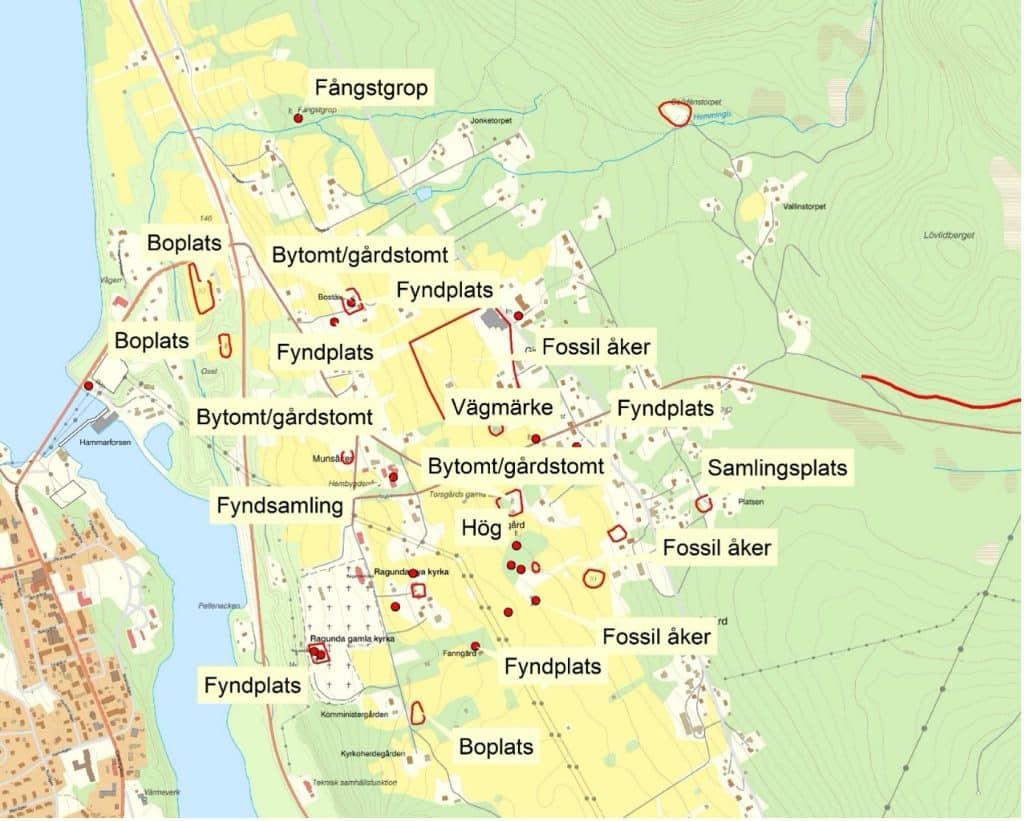Cultural history
Anders Hansson
Geology provides the conditions
Geology provides the conditions for how the landscape is formed, which in turn provides the conditions for all living things. Ragunda municipality's long history is a very clear example of how humans have adapted to the landscape and its opportunities. What is special for the area is the fishing and the use of the river and river valleys with old shorelines and glacial river sediments surrounded by forest land for hunting, reindeer husbandry and logging. The location of the buildings in the landscape often has historical continuity and shows the interaction between man and geology.
The oldest time
Some 10,000 years ago, the current valley of the River Indalsälven formed a long, narrow sea fjord. The fjord stretched roughly to today's Näverede. The River Ammerån also formed a long, narrow sea fjord that ended a little north of today's village of Selet. About 9,000 years ago, land uplift had caused the fjord to extend to the vicinity of Krångede. The coastline slowly receded and 3,500 years ago the sea fjord ended roughly at the county border and after that there was no sea fjord within the current Jämtland county.

An ancient bay
During the 6,500 years that the Indalsälven valley was a sea fjord, people probably lived along the shores of that time. We dare say that because the oldest settlements in the county are roughly 9,000 years old and along the Baltic coast in general there is definitely no shortage of settlements that are adjacent to older coastlines. However, we know very little about the people of that time in Ragunda because their places of residence have not yet been found. An important reason for this is that the county consists mainly of forests. This means that what once used to be beach and coast is now forest, and there it is difficult to find traces of the oldest prehistory. There are plenty of Stone Age settlements and most of them are located next to lakes and streams where they are easy to spot on the shore level. Ragunda municipality is the only municipality in Jämtland County where coastal settlements can be assumed during the Stone Age, so this is both an important and exciting field of research.

Forest and water
The known settlements from the Stone and Bronze Ages in the municipality clearly show how crucial the proximity to lakes and waterways was. Access to water, communication routes, hunting and fishing have been the factors determining where people settled. The forest areas between the waterways have been used for hunting and trapping.


Hunting, fishing and reindeer husbandry
In Ragunda and Jämtland as a whole, there are no traces of agriculture during the Stone and Bronze Ages. Hunting and fishing seem to have dominated until the first Iron Age farms were established. In Ragunda municipality, this seems to happen relatively late. Today, we have no indications of agricultural settlements until the Viking Age, i.e. the period 800-1050 AD. The oldest traces of this can be found in the form of burial mounds found in Pålgård and at Stadsforsen, as well as a few odd finds of Iron Age objects.
It is also at this time that the first traces of more extensive reindeer breeding appear in the county. But regardless of whether you engage in reindeer farming or agriculture, hunting and fishing are still very important.
The first villages
However, any major settlement only takes place during the Middle Ages, 1050-1527 AD. Just as during the Viking Age, this only takes place on the banks of the River Indalsälven. The sedimentary soils in the river valley are the best farmland in the municipality, which explains why this is where we find most of the buildings and the agricultural landscape. Despite agriculture, hunting and fishing were still important for survival. That fishing was valuable is evident from the fact that both the church and Swedish and Norwegian kings had interests in fishing in the Indalsälven since the Middle Ages. Above all the incredibly rich salmon stock of the river invited fishing.

The villages are growing
The next settlement expansion occurs during the 18th and 19th centuries. This is when most of the villages in Ragunda municipality come into being. Many of the trapping pits in the municipality belong to this time. This phase in Ragunda's residential development was heavily dependent on the outlands, the woodland; not only for hunting but also for shielings and pasture. It is also at this time that forestry is becoming economically interesting. Felling and floating of timber to the sawmills on the coast began as early as the 18th century, but it was in the 19th century that the forest industry gained momentum. The next step in the industrialization of Ragunda may be represented by the hydroelectric power plant expansion during the 20th century. The River Indalsälven valley and flowing water run like a red thread through history, from the Stone Age to the present day.

The modern reindeer farming
In the early 20th century, reindeer farming also changed. From the beginning, the reindeer herds were relatively small and the whole family followed the reindeer's migrations throughout the seasons. Back then, the cows were milked regularly, but that changed during the early 20th century. Investments changed to larger herds for meat production. This is the reindeer farming we have today. Regardless of the type of reindeer farming you engage in, the reindeer follow their old migration routes. From the mountain areas in the west down to the forests in the east for winter grazing. At times they move all the way down to the coast before returning up towards the mountains when spring approaches. Today there are five Sami communities that have all or parts of their winter pastures in Ragunda municipality. For as long as anyone can remember, reindeer have grazed here.

